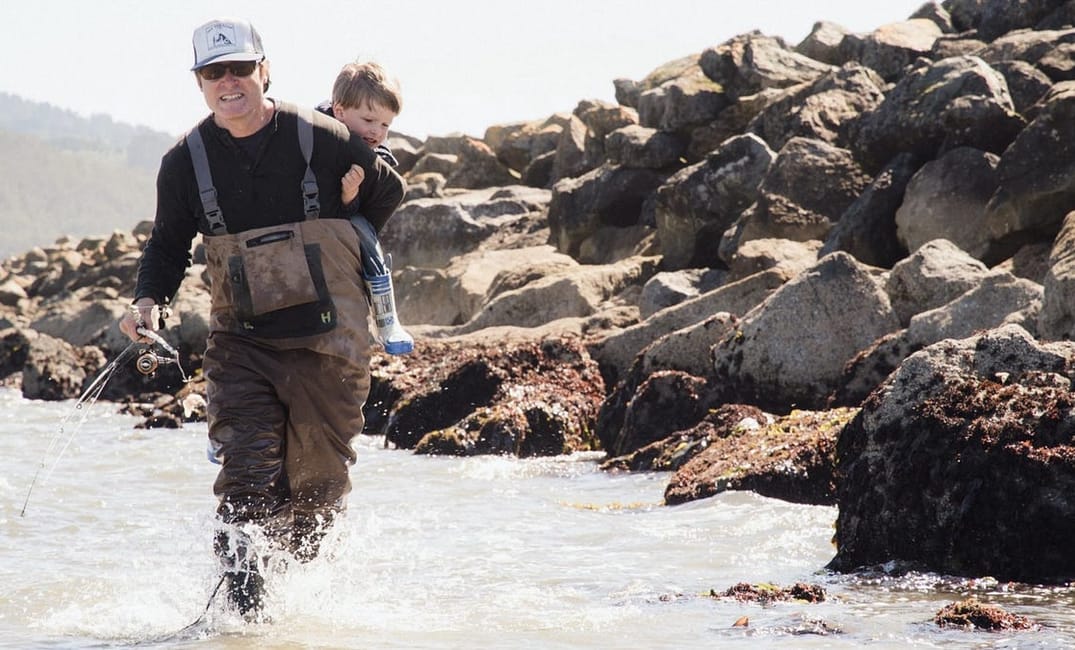
“Have you ever seen a herring spawn in the bay? It’s freaking awesome. The water gets choppy and milky white, and thousands of seabirds just dive-bomb the water, ” says Kirk Lombard, a.k.a. the Sea Forager, as he pulls the crimson guts out of a specimen on a classroom table.
With shaggy blond hair topped by a Sea Forager–branded trucker hat, Kirk looks the part of a former California surfer, minus the apron stained with fish guts. You might never guess that he’s from New York City — until he gets going on a fish-related diatribe — or that he was once an equity actor and a founding member of a puppet theater company.
But for the past two decades, Kirk has been fully fish-focused. And for one day, I’m fully fish-focused, which is why I’m at his workshop in Jack London Square. Kirk is teaching our class of 20 students, all with way more enthusiasm than skill, about proper fish butchery.
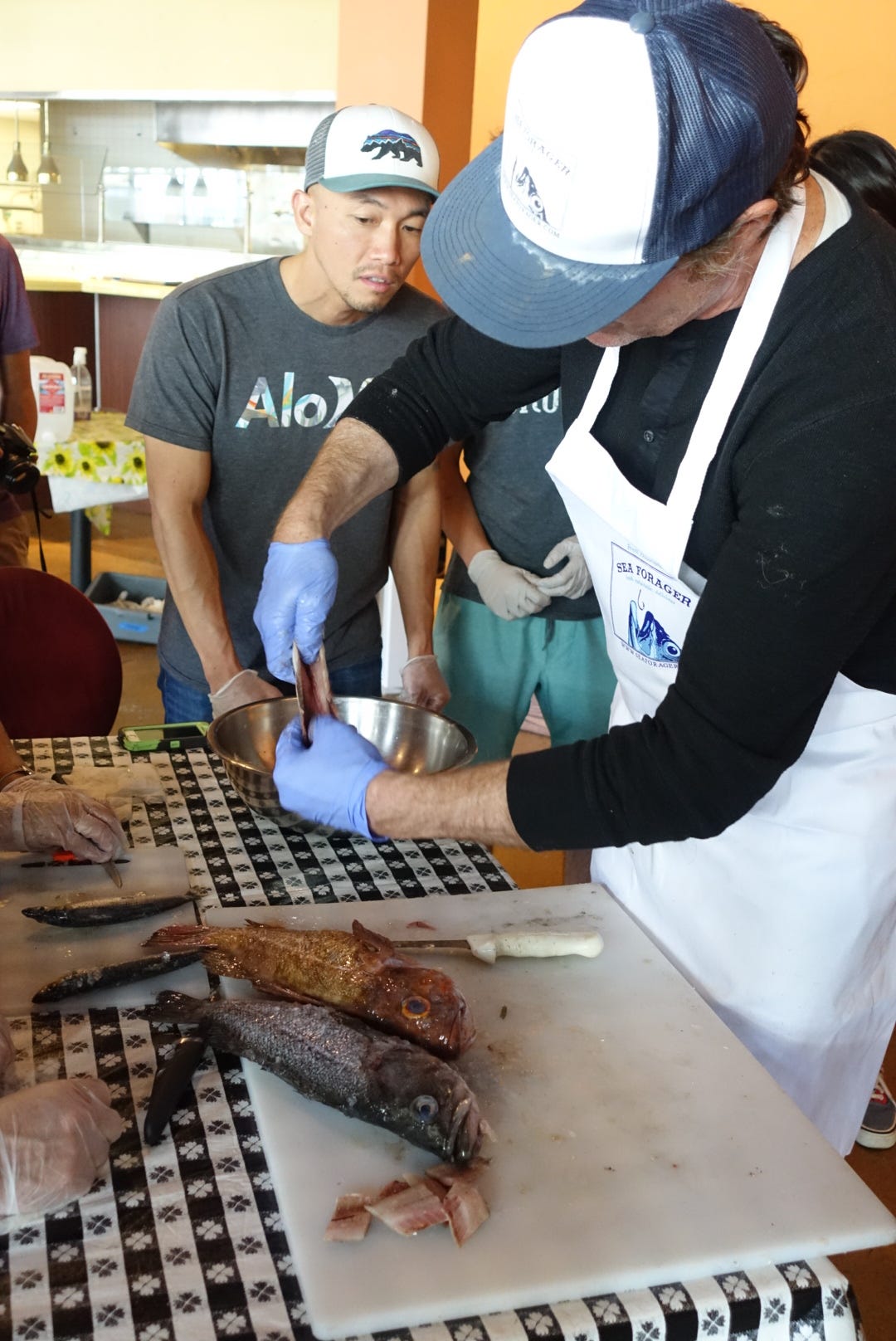
I end up learning more than techniques from the workshop. From the rocky past of the Bay Area herring business to busted seafood myths (e.g., you’re never eating fish caught that day no matter what the menu says), Kirk’s lessons — and wildly gesticulated sea-foraging tales — are what really captivate me. So do the surprises he pulls out of the cooler, including a gray behemoth with a massive row of teeth that’s called a ling cod. “A fisherman once told me he pulled a full-sized murre out of one of these guys’ stomachs!” Kirk exclaims as he wields the giant carcass above his head for us to see.
All the stories and fish-ogling leave little time for squid prep. But Kirk squeezes in a quick demo: remove the tentacles, clean out the guts, take out the quill (a weird plastic-looking backbone), cut off the head and beak, and voilà! He then sends us off with our own two pound bags for practice.
I’d learned about the workshop from an email I get as a member of Kirk’s community-supported fishery (CSF). Being a CSF member means I get regular deliveries of sustainable seafood that Kirk offers at pickup sites around the Bay Area.
Since I joined, I’ve cooked more seafood — red-banded rockfish, cod, sablefish, ahi tuna, Dungeness crab, and abalone — than I’d ever thought possible. Much of my cooking has been inspired by Kirk’s wife, Camilla Lombard, a.k.a. the Fishwife, whose recipes and prep tips are in the weekly emails.
But I’d always wanted to know more about the Sea Forager and his practices. How do you actually get sustainable seafood in the Bay Area? And what exactly does it mean to be a sea forager and a fishwife? I decided to investigate.
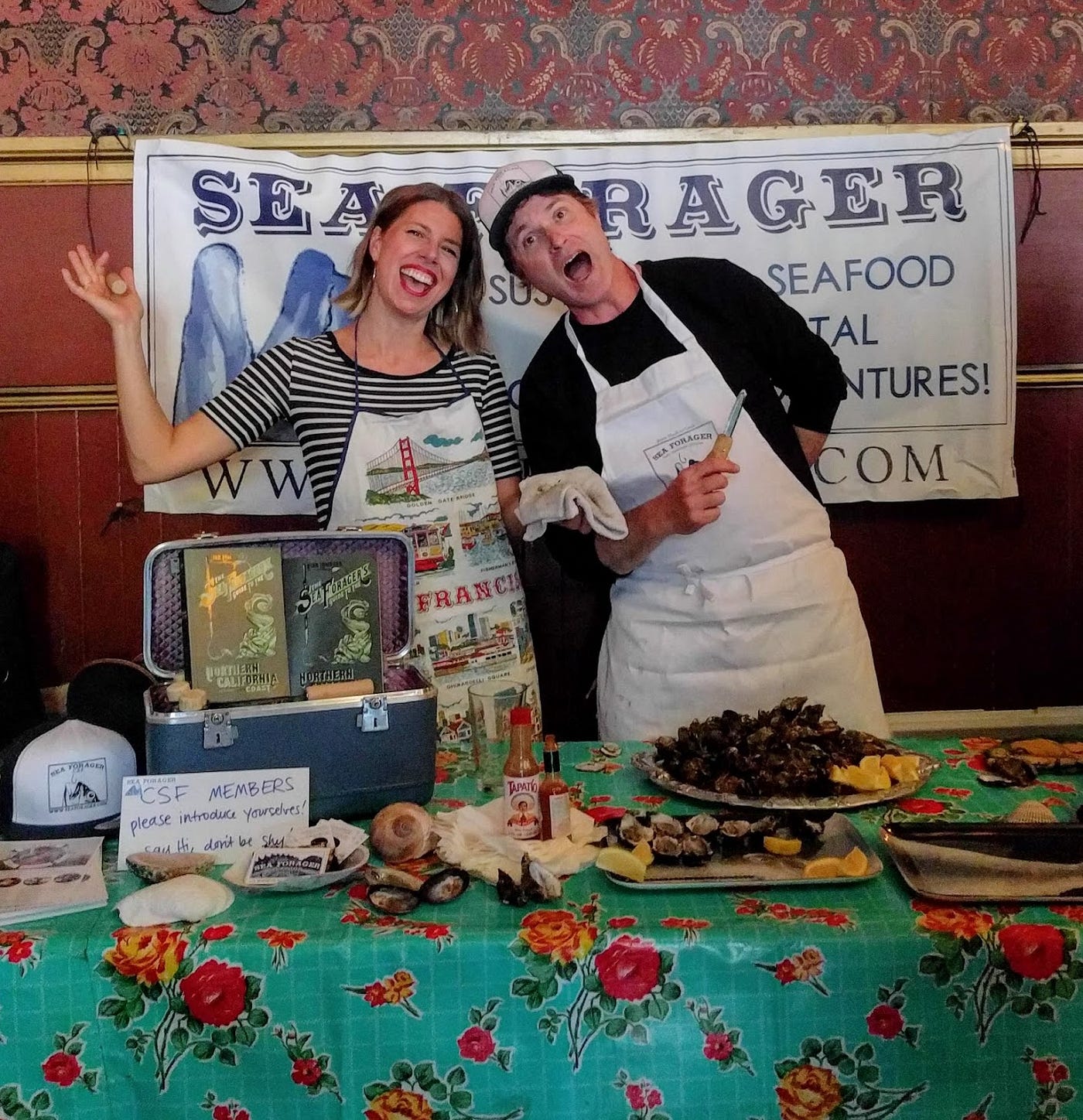
Know Your Fisherman
There are plentiful Bay Area seafood options, but knowing where your fish comes from — and how it’s sourced — makes all the difference when it comes to sustainable eating.
“People need to know that what we’re serving through CSF is not the same thing that they’ll get at Whole Foods or Safeway,” explains Camilla. Blonde, with an easygoing smile, Camilla has a professional background (publicity, bartending, teaching, and founding a nonprofit) as diverse as her husband’s. She’s the engine behind Sea Forager’s marketing and just as passionate as Kirk about sustainability.
“At these major grocery chains, there’s no traceability,” Camilla tells me over email. The biggest consequence of that, she explains, is rampant sourcing via bottom-trawl fishing. This is the kind of fishing in which massive boats drag their nets across the ocean floor to scoop up a target catch — and often other unlucky species of fish, mammals, and coral.
Hauling in 75,000 pounds at a time, these trawlers lower the value of catches “while also decimating the floor of the Pacific Ocean,” Camilla adds. This means that your 10-dollar filet of wild-caught salmon might be a bargain, but it probably isn’t sustainably sourced.
Kirk knows how to avoid bottom-trawled catches better than just about anyone else in the Bay. A former observer for the Pacific States Marine Fisheries Commission, he spent seven years building relationships with Bay Area fisherman and learning about local catches — from herring to night smelt and “rockfish pulled out of storm drains by homeless, drop-line-wielding grandmothers.”
Combining Kirk’s knowledge and Camilla’s marketing savvy (she previously worked as an events and publicity manager for Good Vibrations), the two launched Sea Forager’s CSF in 2013 to help locals benefit from their connections and tap in to the growing demand for sustainable food. Sea Forager’s CSF currently has 880 members and delivers weekly orders to San Francisco, the East Bay, Pacifica, Marin, the South Bay, and San Mateo.
Managing the CSF isn’t easy. Along with marketing, publicity, recipe-writing, social media, sales, and customer service — all handled by Camilla — there’s a complex behind-the-scenes operation.
“It’s a struggle to balance our own high standards, like not serving drag-caught fish, with variety, locality, seasonality, and timing,” says Camilla. Sea Forager delivers fish each Wednesday and Friday, meaning that Tuesday and Thursday are crucial for sourcing, offloading, prepping, and packaging. All of it happens from the warehouse headquarters at Fisherman’s Wharf, where, a few days after the fish butchery workshop, I watch Kirk and his crew pack a day’s shipments — fresh halibut and mussels — into dozens of brightly colored coolers.
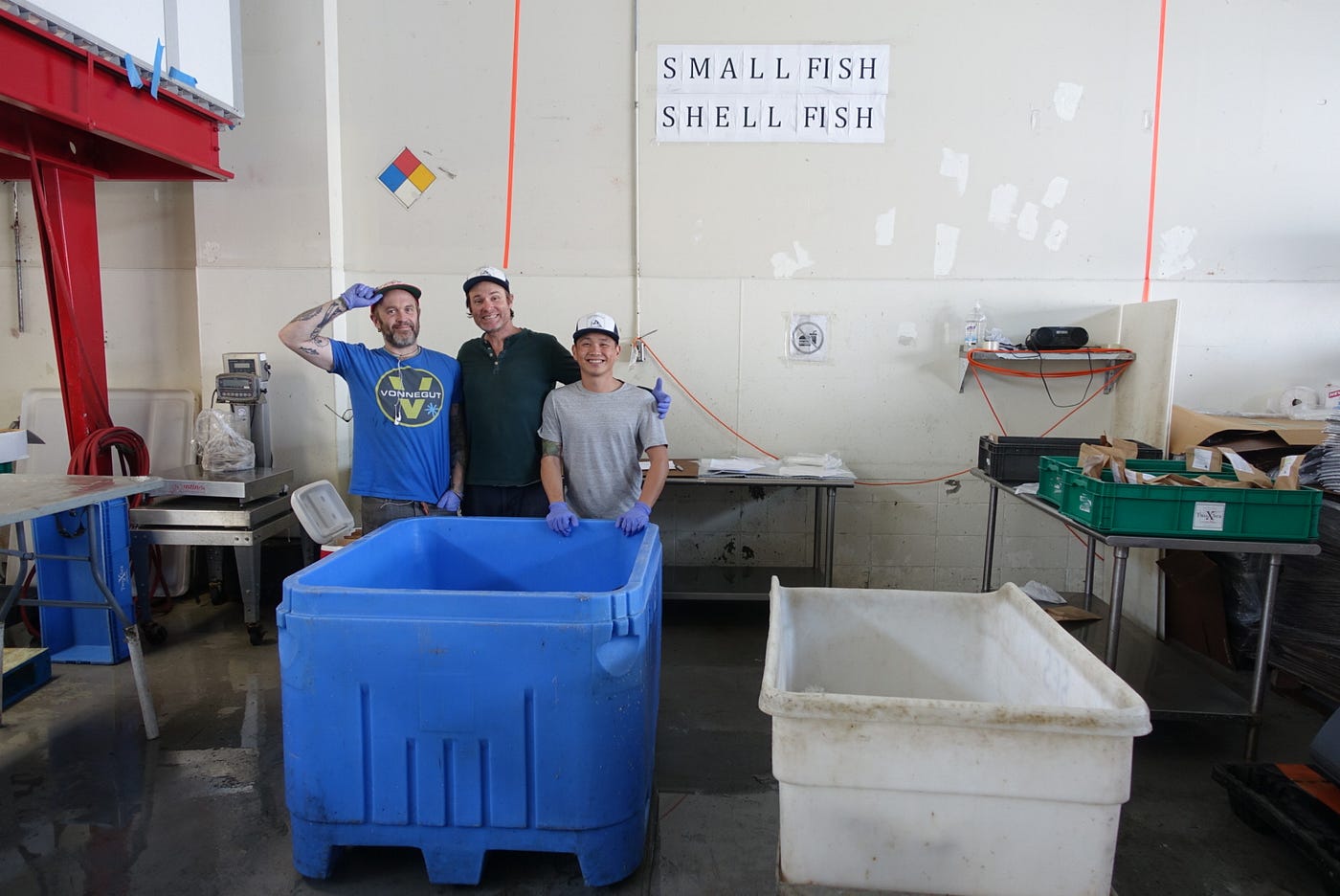
Sourcing is the hardest part. “It’s like being a doctor on call,” says Kirk, as we stand on the warehouse dock facing Golden Gate Bridge. Kirk had been there the previous night, offloading and packing up 300 pounds of freshly caught halibut until 3 a.m. He’d come back to get another 30 pounds from the same fisherman, who’d promised a drop-off at 7:30 that morning.
Kirk checks his phone as I chug my coffee. “He showed up an hour early, waited five minutes, and left,” he says, shrugging his shoulders at the fisherman’s text.
“That’s why he’s one of the good ones. He’s out there instead of meeting me here,” Kirk says, pointing at the Bay, “because he knows it’s prime time to get his catch.”
Kirk gets about half of his CSF supply from this type of high-touch sourcing. The other half he gets from TwoXSea, the only local company that meets Kirk’s sustainability criteria, which includes “no trawl” sourcing, by-catch avoidance, fair wages for workers, and local catches whenever possible.
“The farthest away we ever get fish is Hawaii, which is where we source line-caught ahi tuna,” says Jack Luong, Sea Forager’s director of operations. Despite running on little sleep, Jack patiently answers my stream of questions as he checks the day’s shipment list. Later that day, Jack, Kirk and their team member, Josh, will spend the rest of the afternoon delivering the coolers at drop-off points around the Bay.
In contrast to Kirk’s sourcing, many of the other Wharf warehouses truck in their fish daily from the airport, where it arrives packed in giant crates from Southeast Asia and other far-flung regions. For this bulk of the fish business, guarantees of sustainability, freshness, and fair wages for workers are harder to come by — or nonexistent.
TwoXSea also supplies Kirk with sustainably farmed seafood, such MacFarland Springs Trout from Lassen County. This helps the Sea Forager round out CSF deliveries in seasons when line-caught options are less abundant.
“Our customers pay more to know who caught their fish and how, because it’s not simply a slice of fish,” adds Camilla. “They pay us for a service.”
That service makes it easy to avoid abundant yet unsustainable options, like Pacific swordfish caught by pelagic long lines, which ensnare turtles, whales, and other sea life. Being part of the CSF also exposes members to the wonders of lesser-known catches — like herring or sweet Pacific sand dabs — that don’t usually grace grocery display cases.
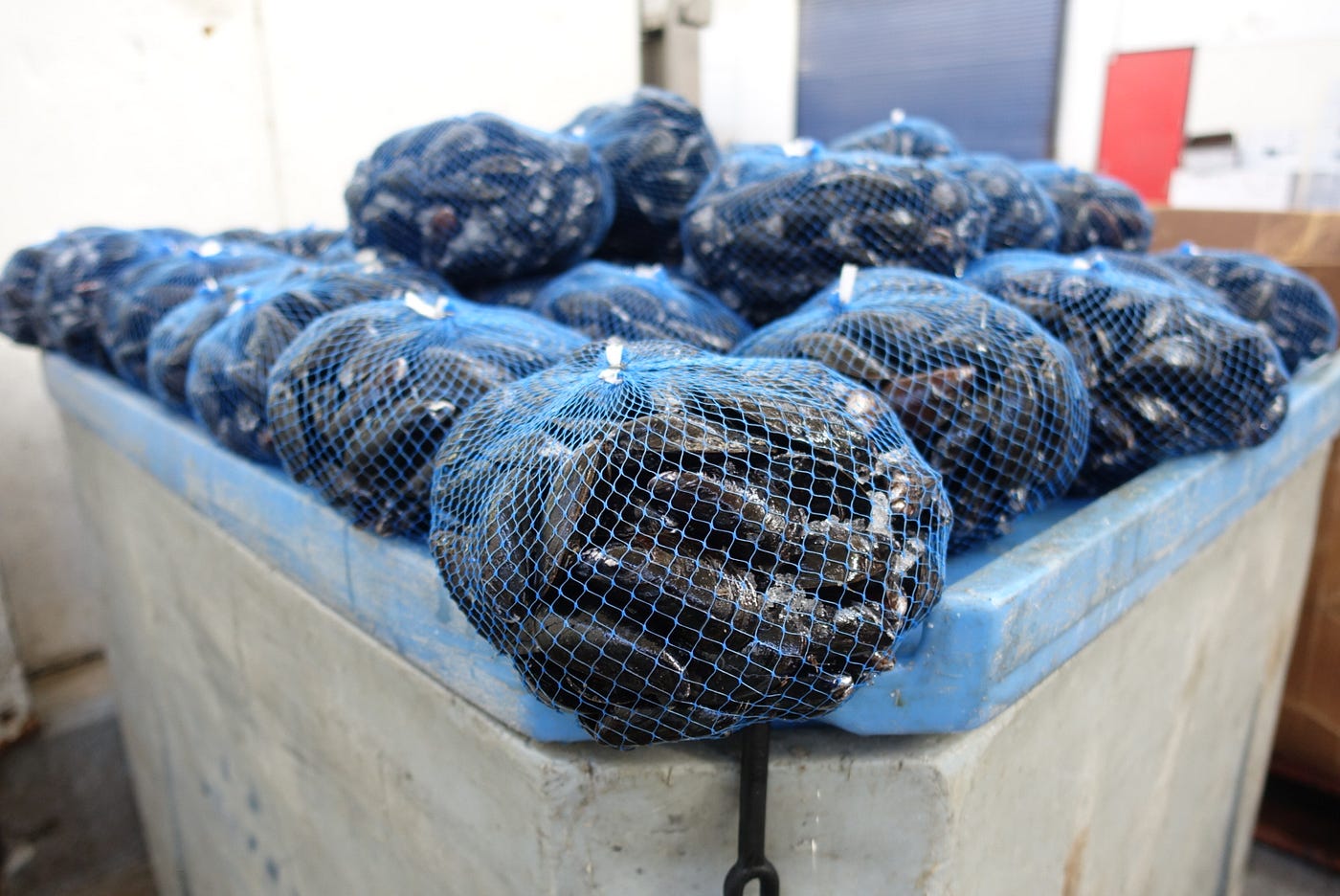
DIY Sustainable Fishing and Sea Foraging
Buying sustainable seafood is one thing. If you want to reap the rewards of DIY fishing and foraging, though, Sea Forager can also help. Kirk and Camilla started their business as a tour company. A few months after joining the CSF, my husband and I found ourselves throwing Hawaiian casting nets in a parking lot near the Marina Green on a windy afternoon while on Kirk’s San Francisco Coastal Fishing & Foraging Tour. We also watched Kirk fish out a rock crab from Yacht Harbor and catch a monkeyface eel with a poke pole, which is basically a hook attached to a piece of bamboo.
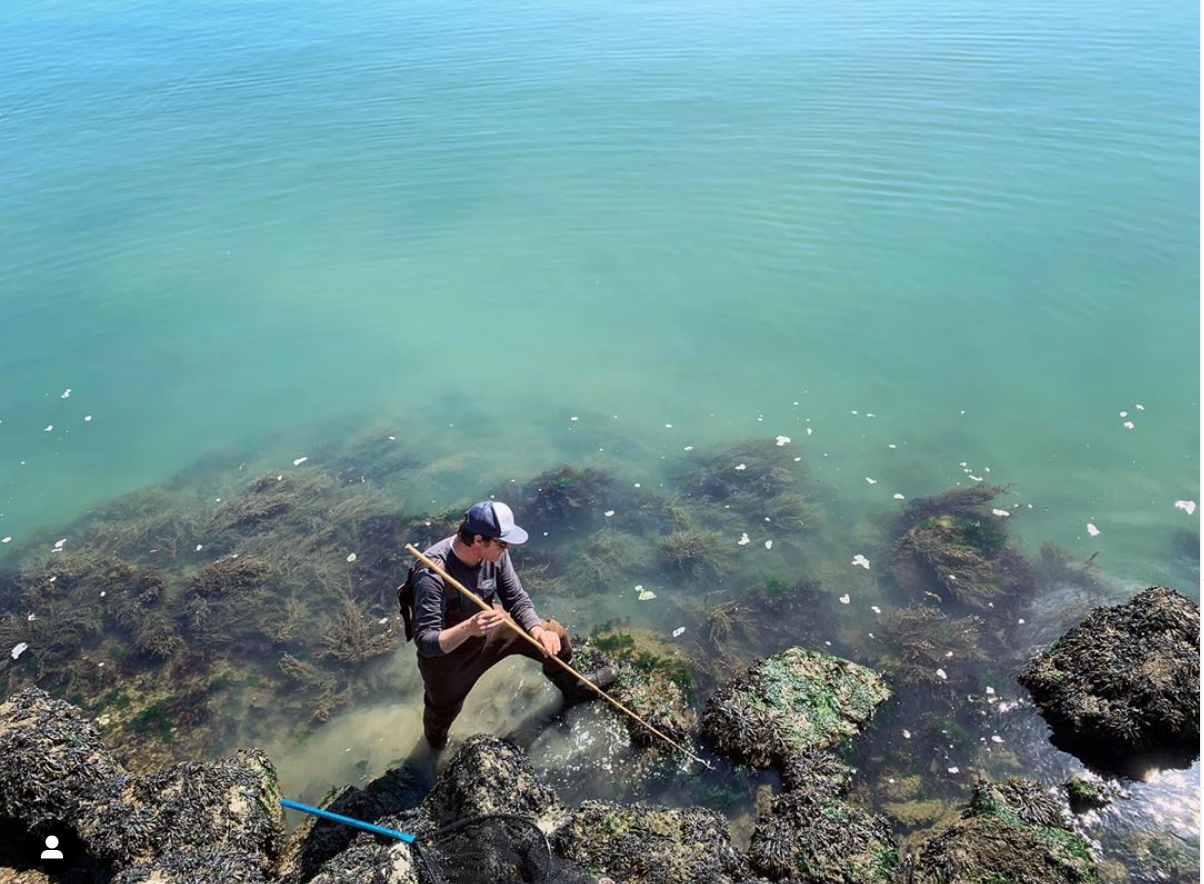
When he wasn’t in action, Kirk schooled us on the basics of Bay Area fishing: how to use a crab trap, throw a Hawaiian casting net, forage edible seaweed, and ensure that you’re fishing sustainably and legally in the Bay. Rule number one: have a valid fishing license unless you are fishing off a public pier. And even then, certain rules apply to what you can catch and keep.
Along with tours, the Lombards have other opportunities — like fish-butchery workshops — to teach the public about sustainable seafood. They also spread the sustainability gospel by promoting Kirk’s book, The Sea Forager’s Guide to the Northern California Coast. Sea Forager also hosts events where CSF members can meet their fisherman and sing songs with the Fishwives, the family’s sea shanty band.
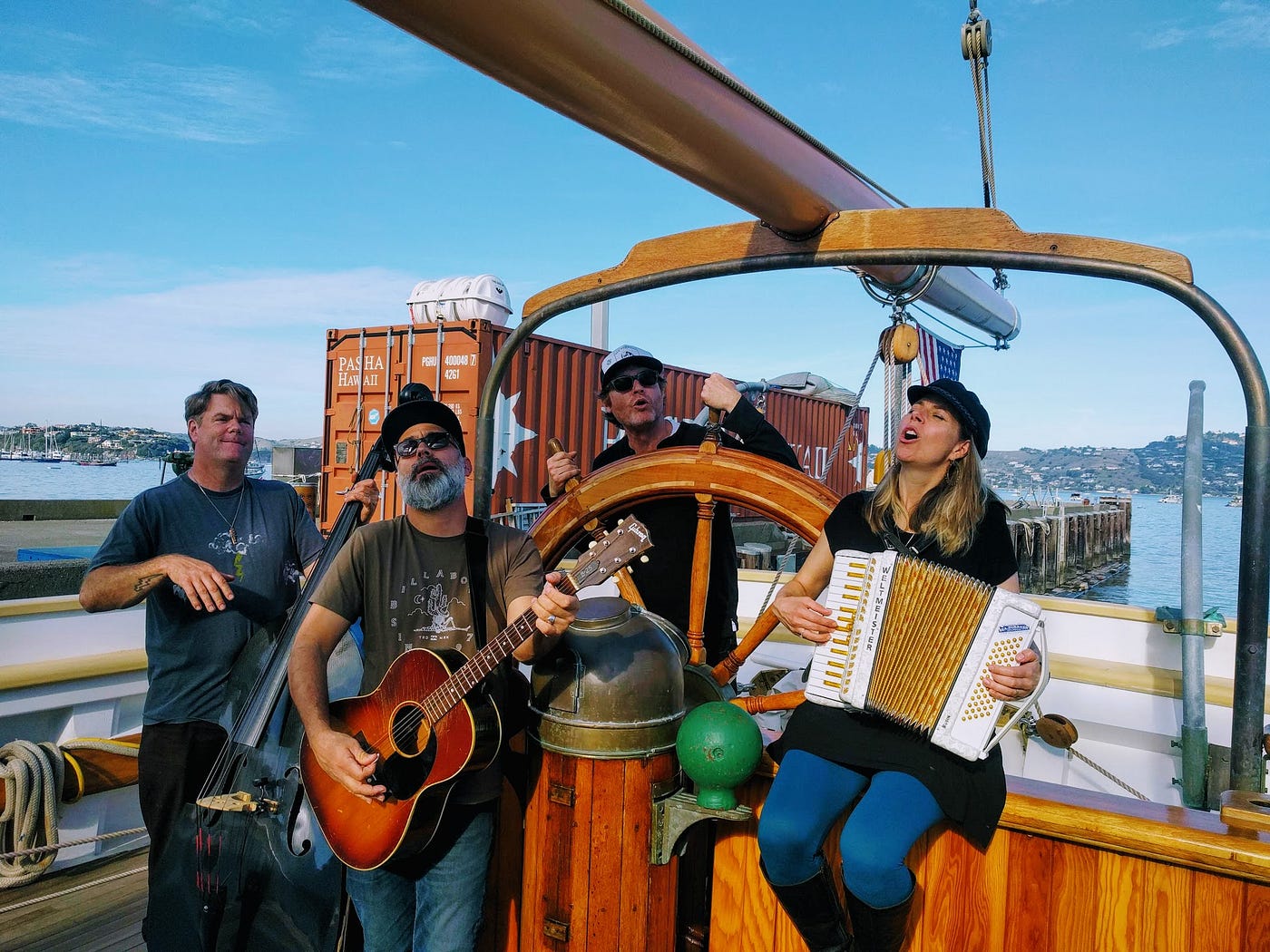
With their two kids in tow, Kirk and Camilla simply adore the ocean. “As a family, we often go to the beach at low tide for coastal exploring and foraging,” says Camilla. And it’s no surprise that fish were seemingly in the stars for the couple. “Our second date was a tour of the fish markets on Clement Street,” says Camilla. “The foreshadowing was through the roof, but I never would have guessed we’d become fishmongers. It has been a winding road for sure, but what a view.”



